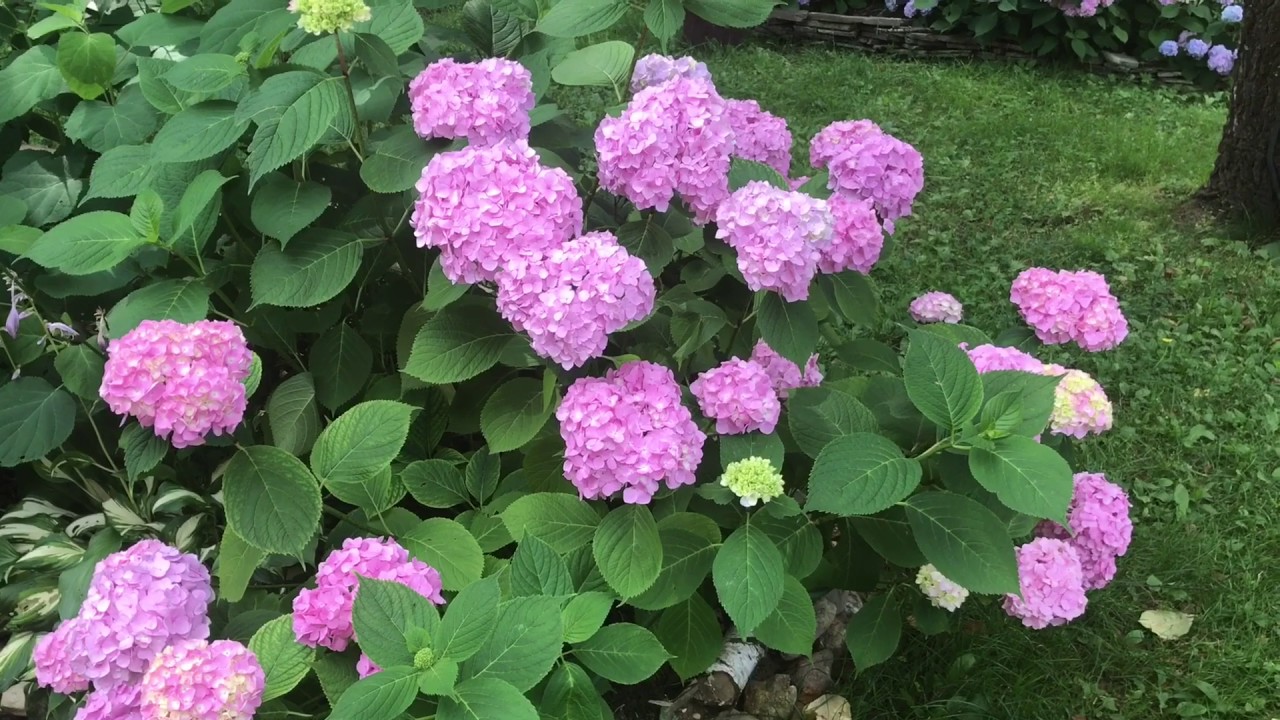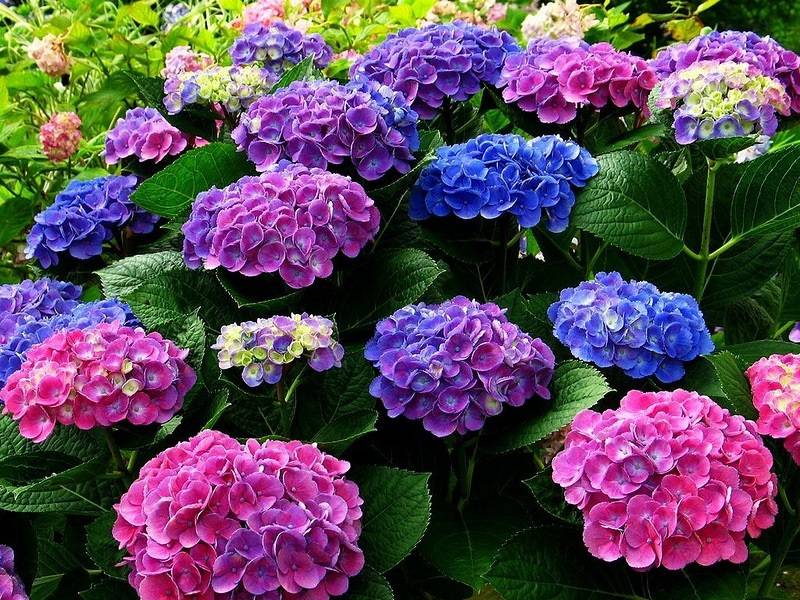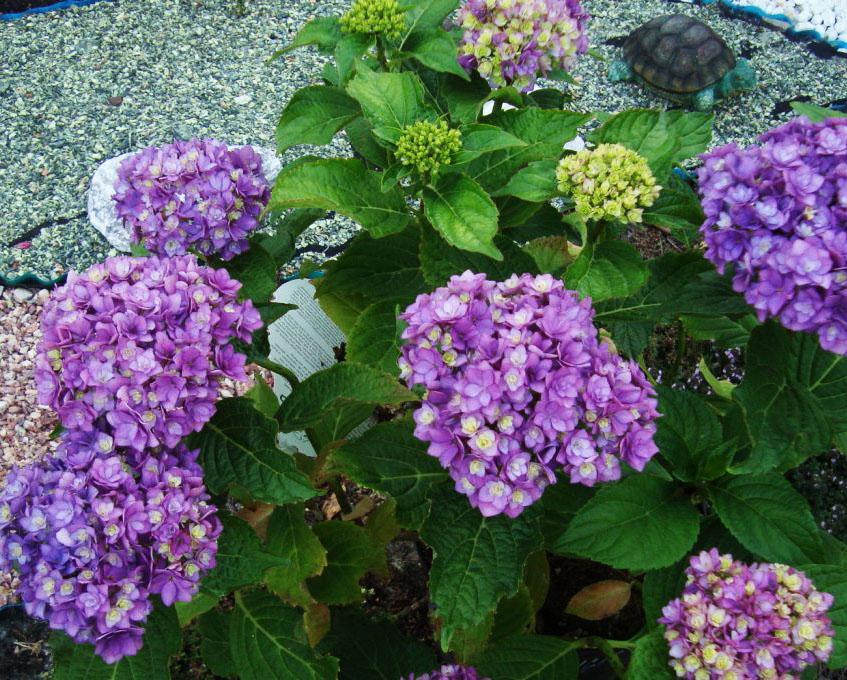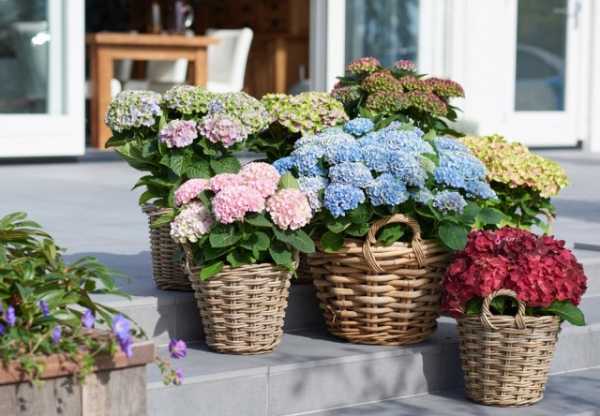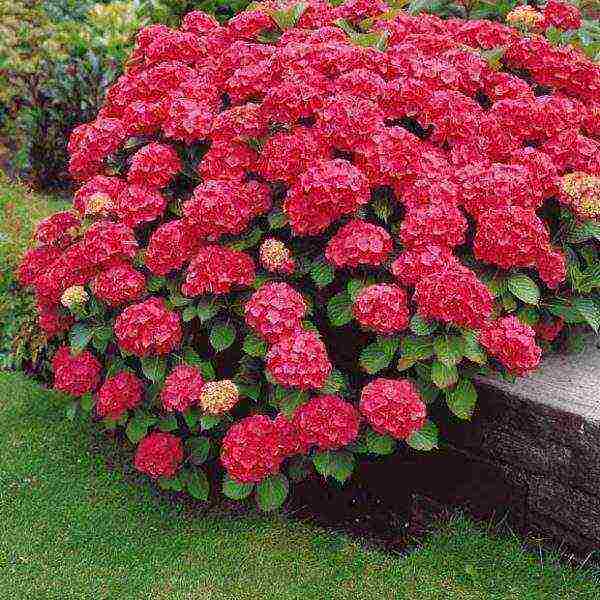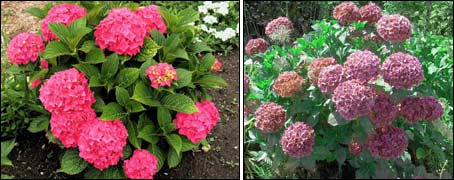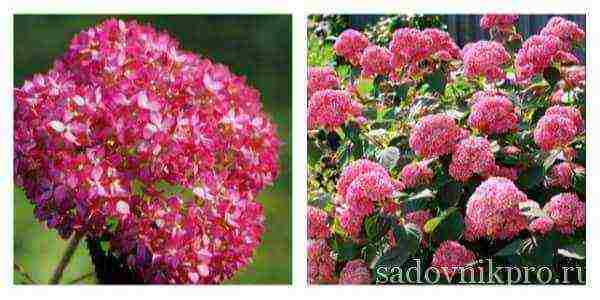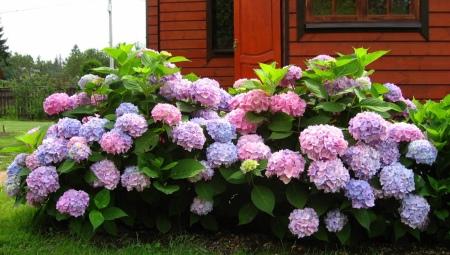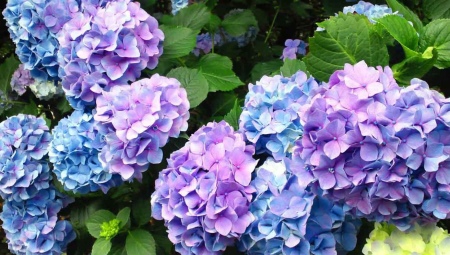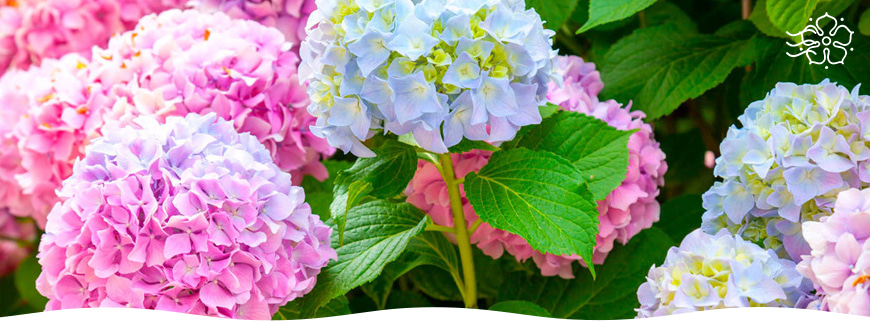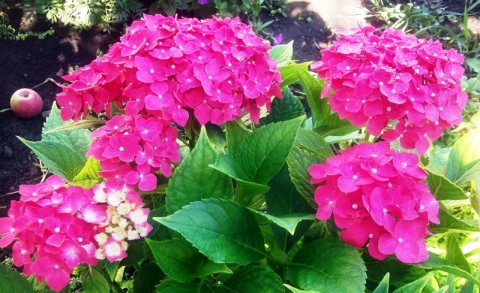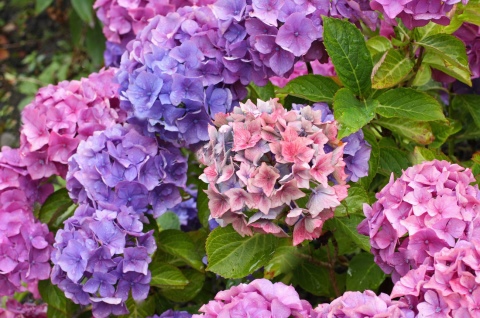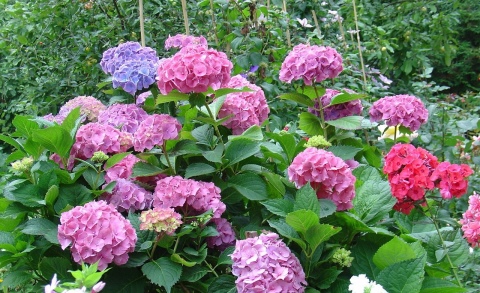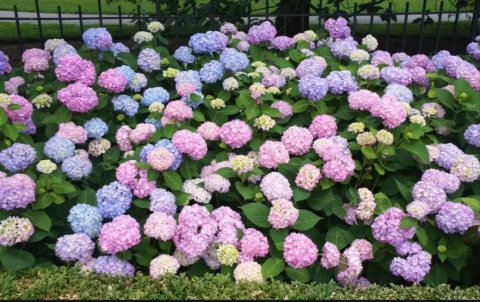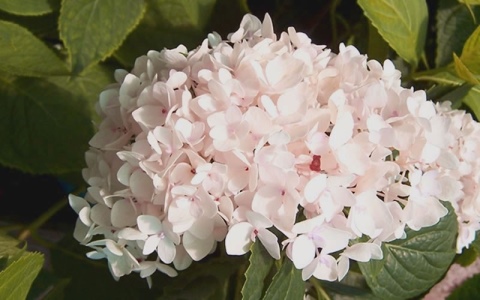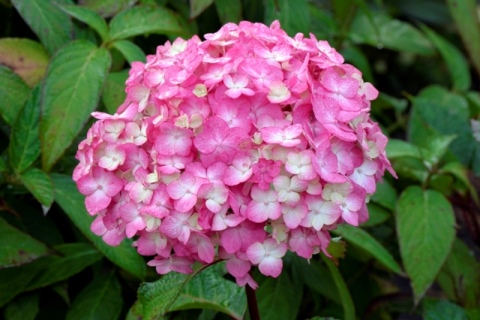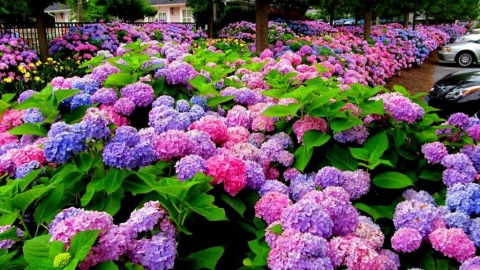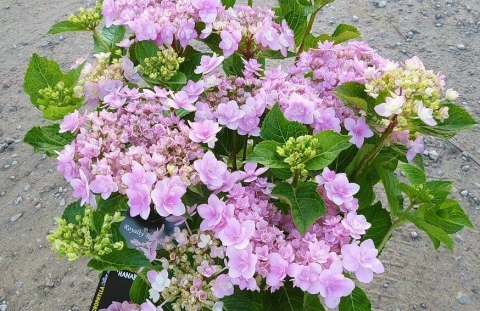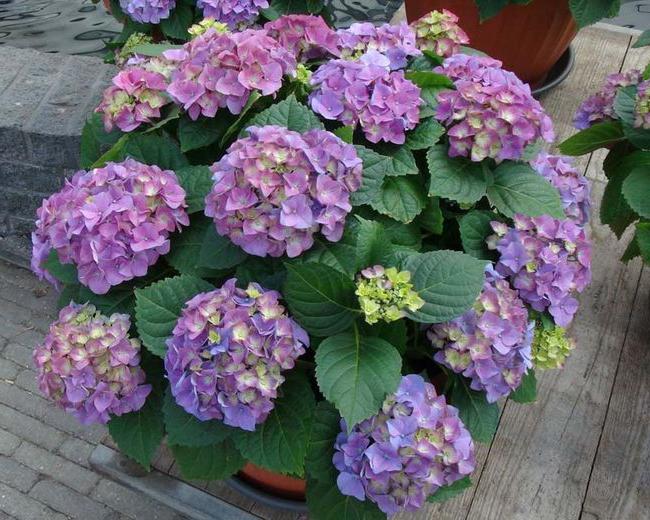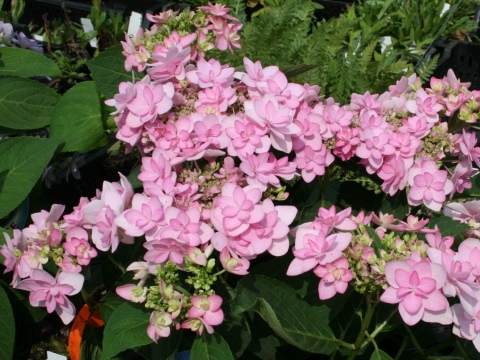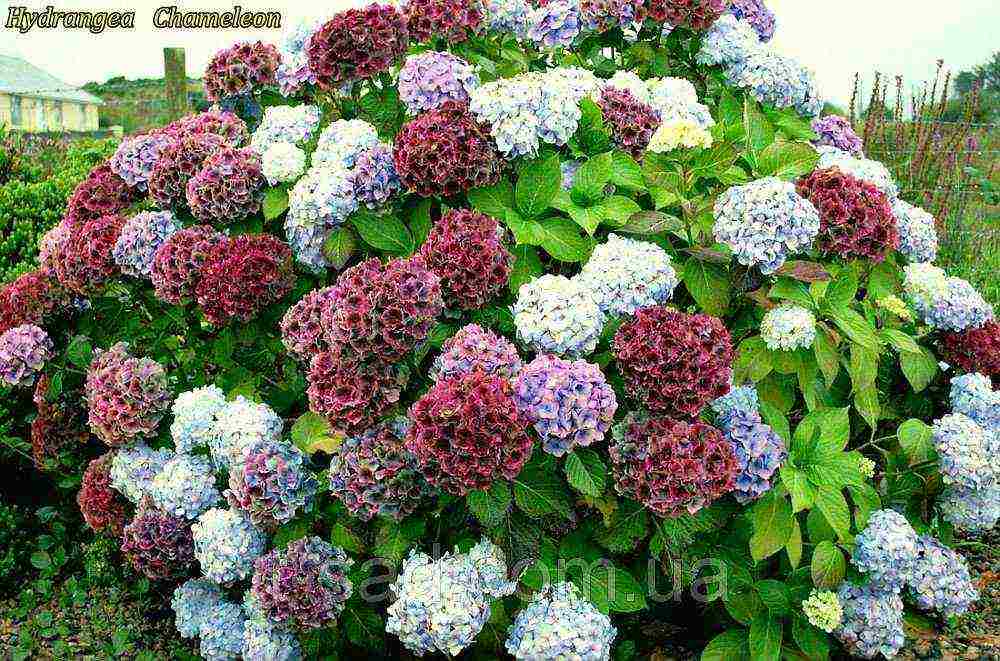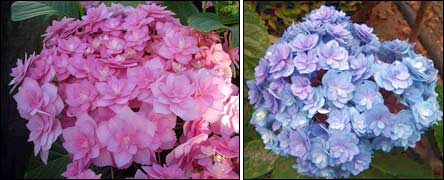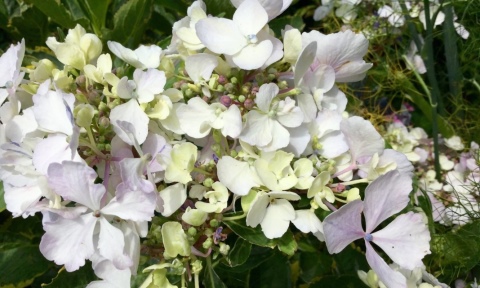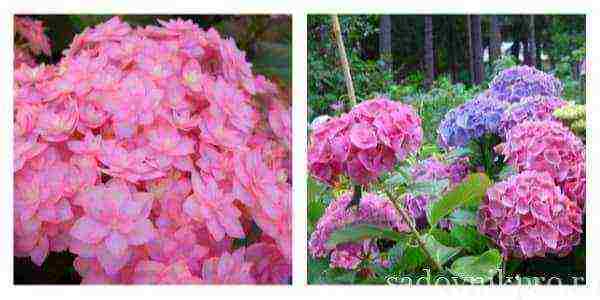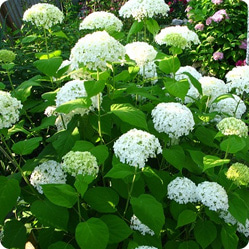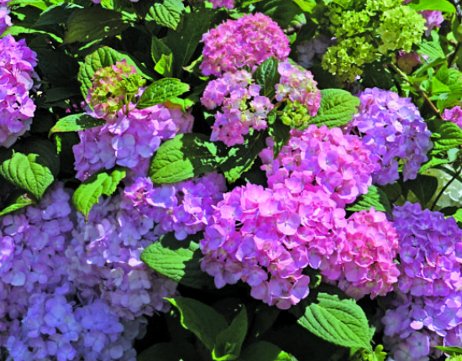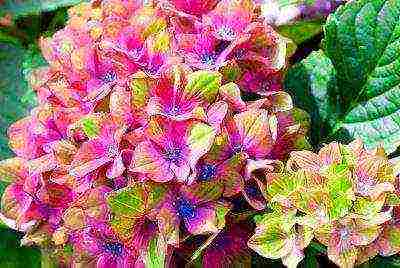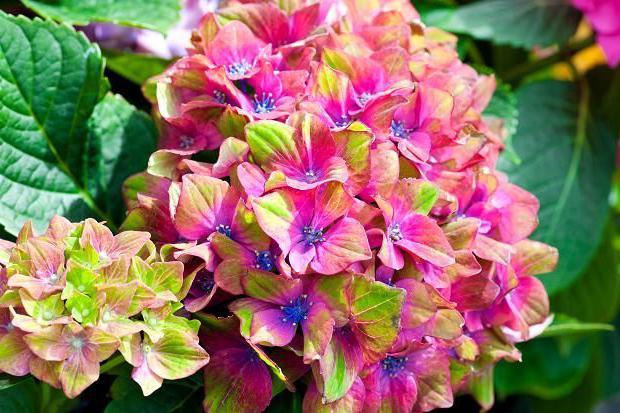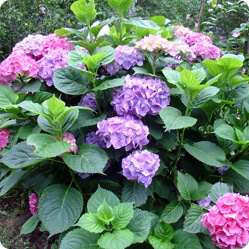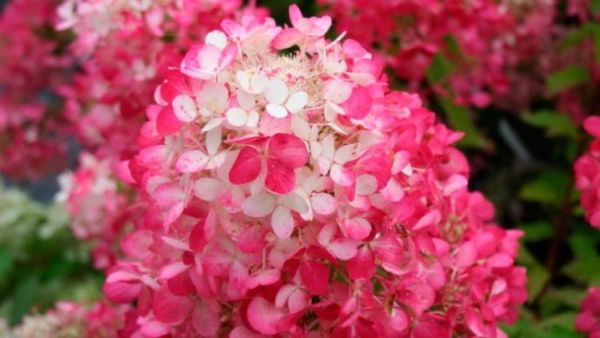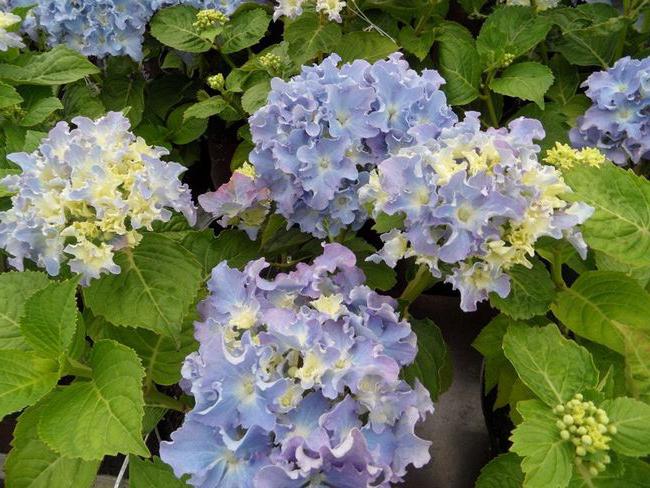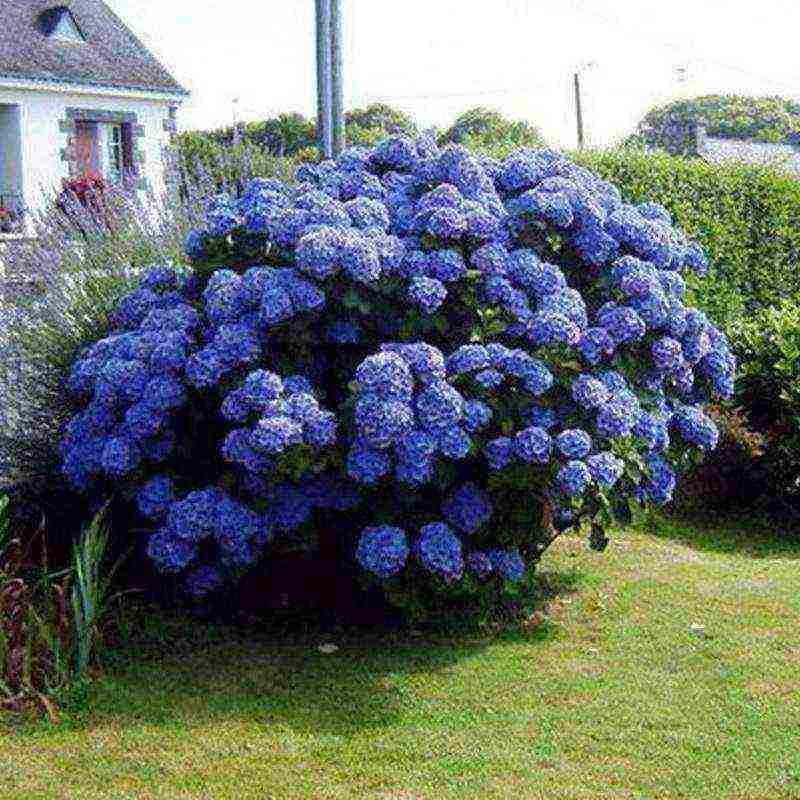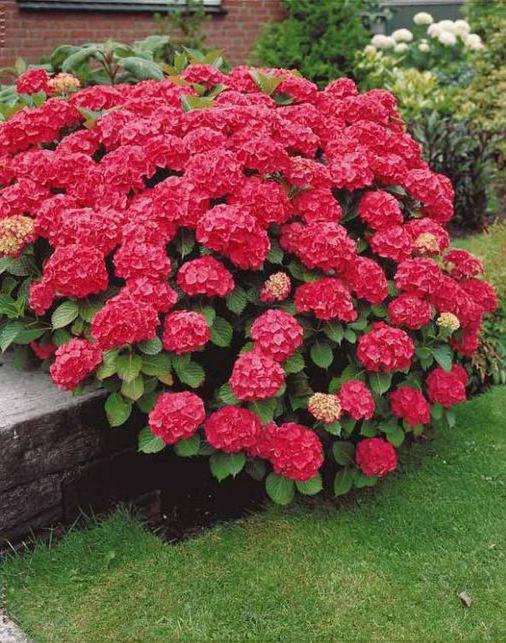General rules of planting and care
Planting red gortesia in the open field should be carried out in early spring or autumn. It is preferable to do this in the spring. A very important point in this procedure is the choice of location. The culture needs an acidic, well-moistened soil. Illumination in this case is not important, since the bush grows well in partial shade and in a sunny area.
Consider the stages of planting a plant.
- A hole is dug, the depth of which should be from 0.4 to 0.5 meters, and the width - 0.4 meters. Provided that there are small hydrangea processes, the hole is made with smaller dimensions.
- A substrate is being prepared, which should include fertile soil, humus, peat. Adding 50 grams of mineral fertilizers will not harm this mixture. The prepared substrate must be left in the well for at least half a month. In the case when the soil on the territory is fertile, it does not need to be prepared in advance.
- The planting material is installed in the center of the hole, while you should not deeply deepen the root collar of the bush. It is necessary to pour soil around the seedling and tamp it. Thus, the root system will be well pressed, without voids around it.
- After planting, hydrangea must be watered abundantly. It is also recommended to sprinkle it with sawdust, bark, peat.
- When all of the above stages are completed, it is worth covering the young plantation from direct sunlight for several days. Thanks to this event, one can count on the rapid establishment of the culture. Planting a red hydrangea can be either single or group. Gardeners should keep a distance of 100 centimeters between flora representatives.
This plant variety loves moisture, so it needs frequent watering. Irrigation should be abundant, each hydrangia requires 10 to 20 liters of fluid.
When the weather is hot outside, it is worth watering the hydrangea once every 7 days. On dry and hot days, it is recommended to increase watering up to two times in 7 days. The gardener should be guided by the condition of the soil, taking into account the rate of moisture absorption. The best option for irrigation is considered to be soft, settled water at room temperature. From time to time, add a little potassium permanganate to the liquid. The best time for irrigation is morning and evening, when there is no heat.
So that the red hydrangea grows well, develops and blooms, she needs to be fed... For this purpose, you can use both organic and mineral fertilizers.
It is especially important to feed the plant during the growth phase. Gardeners can use ready-made commercial complexes that are saturated with magnesium and ferrum.
A water-based make-up with dissolved poultry droppings in a ratio of 1 to 10 gives a good result.
Organic mulch is harvested in advance using wood chips and peat. Mulching is done in a thin, even layer around the bush. The best time for the procedure is late spring, when the soil is well warmed up.
A red hydrangea that has reached 3 years of age needs pruning. The procedure should be carried out at the beginning of spring until the time of bud break and sap flow. Using a pruner, the grower should cut off ¾ of each branch, leaving at least 2 pairs of buds on it. And also it is worth cutting off old, damaged, frostbitten shoots in order to form a beautifully shaped bush.
Types and varieties of hydrangea
The most common hydrangeas in Russia are tree and paniculate species.
Hydrangea tree-like is a shrub up to 2-3 meters in height. Leaves are oval up to 20 centimeters long. Small flowers gather in large lush inflorescences, bloom until late autumn.
Treelike representatives of this genus can freeze out in winter, but recover again in spring. Therefore, it is recommended to cut them off every April almost at the root, so that the old frozen branches do not interfere with the growth of new ones and do not spoil the appearance of the bush. The most popular varieties of this type include:
Hydrangea. Variety "Anabel"
Anabel is a variety that blooms from May to October, large spherical inflorescences formed by large sterile white flowers, flowers turn green in autumn. This variety grows well in acidic soil, loves shade and tolerates winter quite well.
Sterilis is a variety of hydrangeas, which is characterized by rapid and long flowering from July to October; large hemispherical inflorescences change from greenish white to snow-white.
Pink Bella Anna is a variety characterized by bright pink shades of flowers. These hydrangeas adapt well to new conditions, and continue their flowering period until the first frost. This variety is extremely frost hardy and does not require shelter even at -30C.
White Dom is a variety with unrivaled white-cream inflorescences 25 cm in diameter, blooming from June to September, has a spreading crown and grows up to 150 cm.
"Invincibel Spirit"
Invincibell Spirit is a variety characterized by pink blossoms. Later, the color saturation changes from dark to light. This variety is also quite unpretentious, tolerates pruning well, and recovers quickly.
Hydrangea paniculate This species is also represented by shrubs, however, compared to the tree-like one, they are rather low, up to 1.5 meters in height, and their inflorescences are in the form of an extended pyramid.
Vanille fraise
Their leaves are ovoid or elliptical. The first flowers appear from June to July and bloom until late autumn.
During flowering, they can change color from white to pink, and then greenish. This species tolerates winter cold well enough. The most common are the following varieties:
Vanille Fraise is a panicle hydrangea variety characterized by a fast growth rate, large inflorescences (up to 30 cm), as well as originality of color. The petals on their flowers can range from snowy white to bright crimson at the same time.
Wim'sRed - a variety with even larger conical inflorescences, reaching up to 35 cm, they also exude an attractive honey aroma. Inflorescences change color over time: first they are white, then pink, and in the fall they acquire a deep red color.
Grandiflora is a variety with huge panicle-like inflorescences. When unraveling, they have a creamy white color, in full color they are snow-white, at the end of summer they turn pink.
Hydrangea "Bobo"
Bobo is a relatively young variety of dwarf hydrangea, up to 70 cm high. The inflorescences are initially lemon green, whiten or turn pink as they bloom. They prefer shady places with moist acidic soils. This variety is often grown in containers that are placed on terraces, gardens or loggias.
Phantom
Pinky Winky is one of the best varieties of this species, it can be a shrub or a small tree with a wide rounded crown, which grows 30 cm annually. The inflorescence of the panicle is initially white and then turns purple.
Phantom is a highly prized variety with a honey aroma and luxurious buds. Which are creamy in summer and pinkish in autumn with yellow tops. The petals of these hydrangeas are somewhat different from the others: they are not so densely located to each other and have a more elongated shape.
Large-leaved hydrangea
Large-leaved hydrangea is a heat-loving shrub that grows up to 2.5 meters in nature and up to 0.6 meters if grown at home.They bloom from June to October, their inflorescences are light green, blue, variegated or pink, of a wide variety of shapes.
Hydrangea oakleaf
Curly or petiolate hydrangea are creepers with inflorescences. Such hydrangeas grow extremely slowly, although they can rise up to 20 meters in height, they can take root only in the southern regions.
Hydrangea is oak-leaved - these are rather large shrubs up to two meters high, cone-shaped inflorescences are white, they have leaves in texture similar to those of oak leaves, which is why they got their name. The frost-resistant species is suitable for cultivation only in the southern regions.
Of the varieties listed above, the gardener needs to choose the one he likes, and choosing a place on the site will not cause much trouble.
Features of growing a shrub
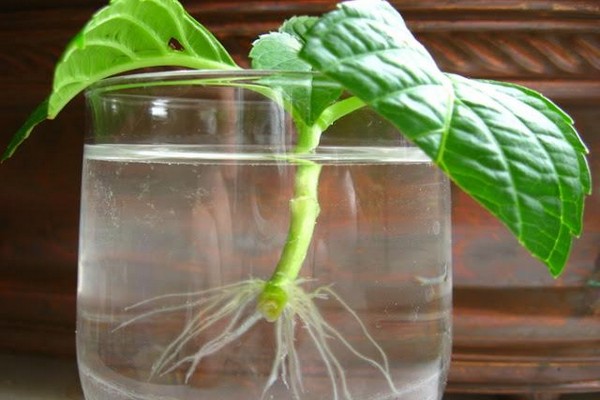
In the cultivation of hydrangeas, as in principle, any flower has its own nuances and characteristics. Hydrangea in the climate of the Moscow region is quite difficult, but the result is worth all the effort that will have to be made. If you set yourself a goal to grow these noble flowers on your site, then be sure to listen to all the advice
When choosing the variety you want to grow, first of all pay attention to frost resistance. It should be no more than 10 degrees below your standard temperature.
And the remaining temperature difference is controlled by the shrub insulation for the winter.
For the comfortable development of hydrangeas, you need fertile, acidic, and most importantly moist soil. But in no case should the water stagnate, otherwise the roots can very quickly begin to rot, and the plant will die, but drought can kill the plant just as quickly. Precisely because the large-leaved hydrangea is very demanding on the composition of the soil, it is advisable to prepare the soil mixture before planting it. This requires land mixed with compost or humus, peat and sand in proportions of 2: 2: 1: 1.
Also, the large-leaved hydrangea is very demanding on the place in which it will grow for many years. But the sun's rays should not be direct, but a little scattered. Both in direct rays and in the shade, it will not feel very good. Hydrangea, in principle, is used to high humidity, so in the heat it will not feel very good. But also considering the fact that in the shade on the bushes there are significantly fewer flowers, and their size leaves much to be desired. So, in what place is it best to plant it, draw your own conclusions.
Reproduction of different varieties of hydrangea suitable for the Moscow region
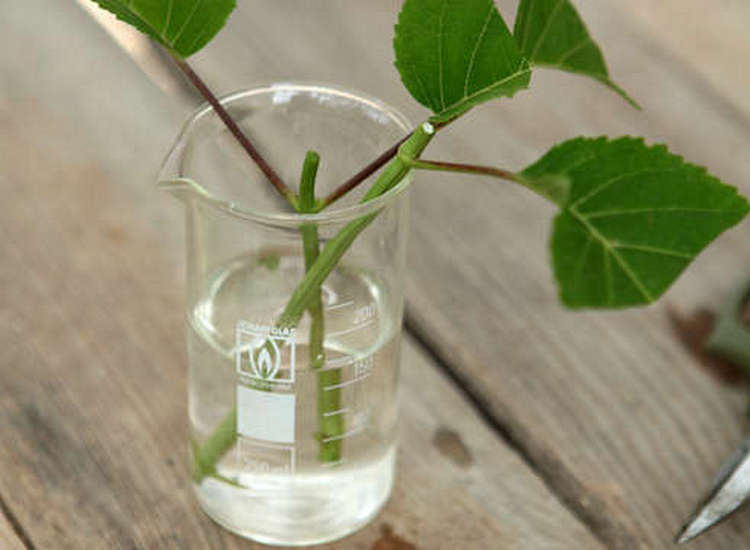
This process can be carried out in three ways:
- cuttings;
- layering;
- dividing the bush.
Propagation by cuttings
To propagate a tree hydrangea by cuttings, it is worth completing several points:
- Cuttings are taken and cut with 2-3 pairs of leaves.
- The sheet plates are cut in half.
- The surface of the resulting sections is treated with a growth stimulator.
- Further, the petioles are planted on the prepared loosened soil and buried in to the middle of the internode.
- After planting, the petioles are covered with plastic half-cut bottles.
Reproduction by layering
This method is the simplest. To implement it, you must first clear the lower shoot from unnecessary leaves, gently tilt the plant to the dug 15 centimeter ditch and fill it with soil mixture, leaving only the top of the shoot on the surface.
It is necessary to care for the layers until the end of autumn. This process is accompanied by constant watering and the addition of fresh fertilizer. By the onset of spring, a daughter plant will appear. The final action will be to cut it off from the main bush and then transplant.
Reproduction by division
This process is carried out using a shovel, pruner or sharp knife. For this method, the plant is pre-dug up. The cut parts should be planted in a previously dug hole and then buried with soil.
The nuances of growing large-leaved hydrangea in the Moscow region
Growing large-leaved hydrangea in the Moscow region is an activity for the most enthusiastic gardeners. But if you have set a goal to decorate the site with these capricious beauties, follow our advice.
- Frost resistance. Having decided to buy a hydrangea in the Moscow region, choose varieties whose frost resistance differs by no more than 10 degrees from the lowest winter temperature in your area. That is, if in winter the thermometer drops to –30 ° С, then plants that can withstand frosts down to –20 ° С are suitable for you. You can easily compensate for the difference by choosing the covering material correctly.
- The soil. Hydrangeas love moist, fertile soil with a slightly acidic reaction. Both drought and stagnant moisture can kill a plant, so it is very difficult to grow a shrub on sand and clay. The ideal potting mix is prepared on the basis of garden soil with the addition of compost (can be replaced with leaf humus), peat and sand in a ratio of 2: 2: 1: 1.
- Landing site. In central Russia, hydrangeas do not feel well both in the open sun and in the shade. Accustomed to high humidity, they will suffer from heat in the midday hours. But with a minimal amount of sunlight, they are unlikely to please with abundant flowering. Therefore, look for a light gliding shade for the shrub or a place with the morning sun.
- Pruning. Most varieties of large-leaved hydrangea bloom on last year's shoots, as well as on shoots that have grown from new buds on last year's branches. The closer the young shoot is to the top of the branch, the higher the likelihood that it will bloom. Therefore, when pruning, try not to drown out the bush and not deprive it of the opportunity to bloom.
- Preparation for wintering. The difficulty of wintering is that the branches of the bush must be preserved entirely - from the base to the tips.
For shelter options that will help hydrangeas survive the winter without loss, read our material.
Shelter hydrangeas for the winter
How to properly cover a hydrangea for the winter, so that in the spring it will again decorate the garden with renewed vigor.
If you have failed over and over again when growing large-leaved hydrangeas in the ground, do not despair. Try planting the plant in a container with a special substrate. When cold weather sets in, dig out a bush, peel it of leaves and take it to a cool place until spring. For normal wintering, the air temperature should be 0-5 ° C degrees. This method is suitable for growing varieties of even the 7th winter hardiness zone in the Moscow region and greatly simplifies the control over the acidity of the soil.
Don't discount the ability to grow a large-leaved hydrangea in a pot. Mini shrubs in a tub always look original, giving the garden a noble entourage. In addition, hydrangea pots are a wonderful decoration for terraces, patios, balconies and patios.
***
It is hardly worth expecting that the inflorescences of large-leaved hydrangea grown in the Moscow region will be as lush as shown in the photo from the catalog of nurseries. Nevertheless, you have every chance to decorate the garden with spectacular bushes that will delight all neighbors.
Repairing varieties of hydrangea
There are even remontant varieties of hydrangeas, they are able to bloom not only on last year's branches, but also on young ones. Thanks to this, hydrangea blooms will be stable and uninterrupted. And if the bush freezes during the winter, it will not be critical. But do not forget that remontant varieties always begin to bloom later than normal ones. But they endure the winter more steadily, but during repeated frosts, they must be monitored and re-insulated.
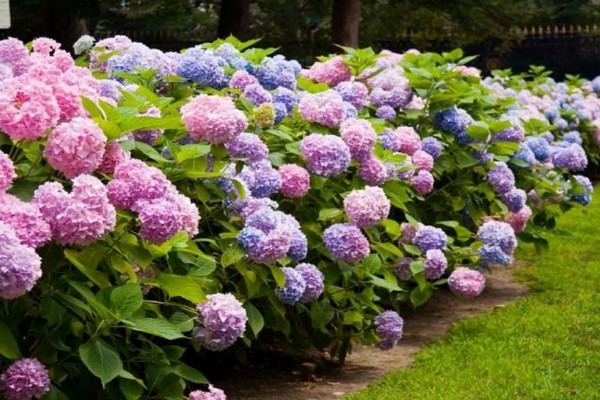
Endless summer, or Endless Samer - these varieties of hydrangeas are one of the most popular among remontant flowers in the Moscow region. Basically, they attract gardeners with their frost resistance. Flowers of this variety, unlike many others, bloom for a very long time, forming inflorescences several times per season.And their colors can be completely different, and this shrub grows in height no more than 1.5 meters.
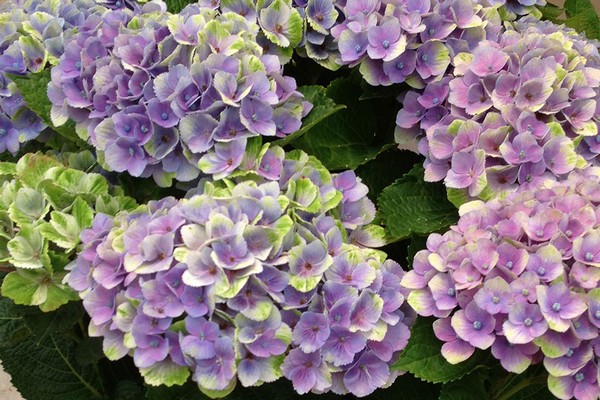
Magic four seasons - the flowers of this variety are very original and unusual. There are various spots and stripes on their petals. During the entire flowering, they are constantly changing. This variety, simply by its appearance, immediately conquers the hearts of absolutely everyone. This flower can be called a chameleon, because it constantly changes its color. By itself, the bush grows quite compact, only about a meter. Inflorescences grow up to 30 cm in diameter. But the constantly changing color cannot be called unambiguously. For the winter it must be insulated, because it will be very sorry and insulting if this beautiful bush disappears.
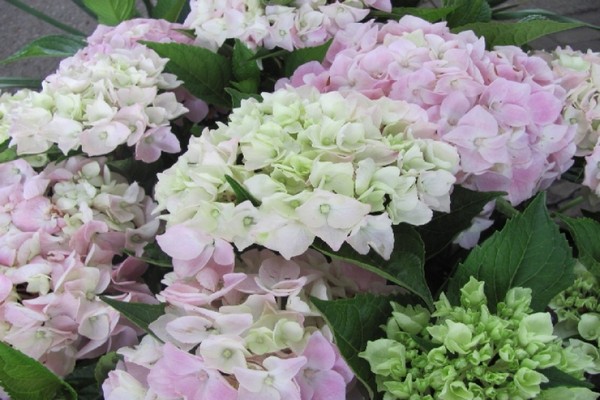
Doppio Bianco - this delicate variety came to us from Holland. He, unlike many, is not whimsical at all. And on its small bushes, which grow no more than a meter, just a huge number of large, beautiful inflorescences grow. This variety begins to bloom earlier than others, and in time it takes longer. Romantic natures compare each inflorescence of this shrub with the bride's bouquet. And she is also the originality of this shrub in that initially the flowers have a delicate white color, but green specks appear on them closer to autumn.

Forever, or Foreveo and Ever - these varieties are also very unusual, because they have two colors. Moreover, the colors can be completely different colors and always with a fluffy rim. Bushes of these varieties are very compact, they do not even grow up to a meter. That is why these varieties are great for home cultivation, and the bushes grow very slowly, which is another plus of this variety.
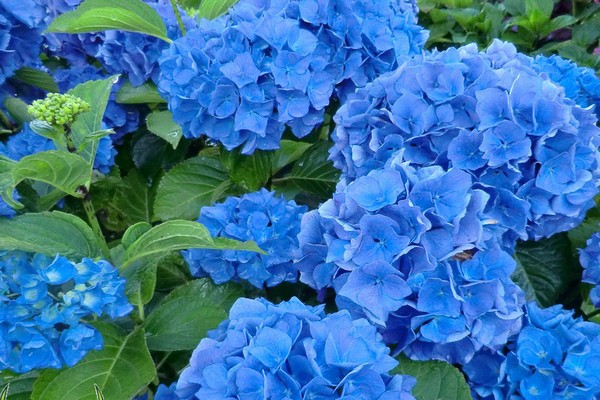
Renata Steiniger - this variety is gaining more and more popularity among other varieties. Basically, its flowers are bright blue, but in order for it to be more saturated, various fertilizing that he simply needs will come to help gardeners. It often happens that flowers of completely different colors bloom on one bush. Gardeners also like this variety because it can begin to bloom in the very first year after planting.
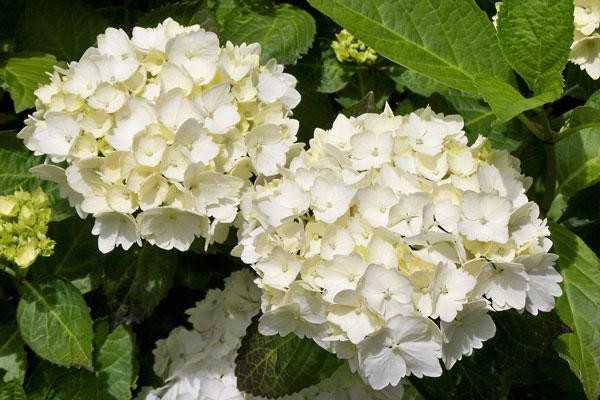
Shneeball - its name is translated as "Snow Globe" and this is fully justified by its appearance
In principle, when you choose a sotr for landing, sometimes it is simply impossible not to pay attention to the "Shneeball". This shrub is quite compact with huge, white, globular flowers.
Outwardly, they look like decorative, but to the touch they are very delicate and pleasant.

You and me, or Yu and me - these varieties look very original with their small double flowers gathered in large inflorescences. These varieties are not whimsical in cultivation at all and what is another plus is that they begin to bloom already in the year of planting. Initially, the flowers of this variety are white, and over time they change their color to pink or blue, depending on the composition of the soil.

Blueberry cheesecake, or Blueberry Cheesecake - this bush looks very unusual due to the fact that it grows more in width than in height, and its height is slightly more than 1 meter. This variety has small pink flowers, and by autumn the bush itself changes its color from green to red, which also looks very unusual and original.
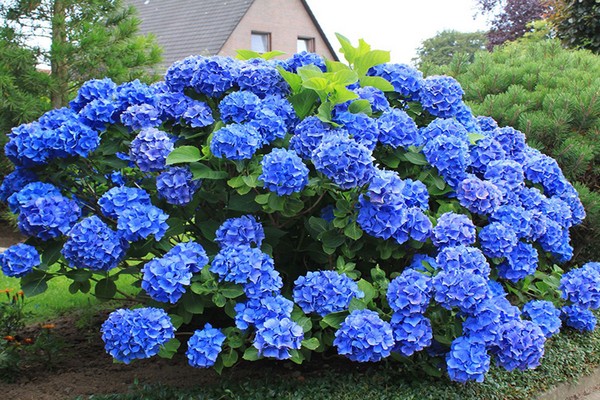
Earley blue - this shrub can be grown not only outdoors, but also in pots. The difference between this hydrangea shrub from the rest is that it has a very powerful root system. It must be planted in a sunny area and watered very often and a lot, because he loves moisture very much. For the winter, it must be covered, and in the spring, top dressing must be applied. After all, this is what affects the pomp and beauty of blue inflorescences.
It often happens that inflorescences in remontant varieties do not form at the right time, mainly after the winter is too frosty and the bushes were not properly covered.
How to paint?
It's no secret that you can make a plant with blue, blue buds from a pink hydrangea, and a lilac plant from a red one. However, no one has yet succeeded in making a blue culture out of white. The change in the color of the inflorescences is facilitated by a change in the acidity of the soil: on alkaline soils they are pink, and on sour soils they are blue. The color change occurs as the plant matures.
To artificially stain the culture in a blue tint, you need to add a solution of aluminum or iron alum to the soil near the bush once every 14 days. A young representative will need 5 liters and an adult 10.
Diseases, pests
Rough hydrangea has good immunity. However, it can be affected by various diseases, and it is also attacked by insect pests.
- Chlorosis. The leaves brighten, the veins against their background become dark. The reason is the alkalization of the soil. In this case, the plant is treated with a solution of ferrous sulfate (45 g / bucket of water).
- Powdery mildew. The leaves are covered with oily spots. After some time, the spots turn yellow, darken. The bushes are treated with foundation.
If spider mites, aphids, weevils, bugs have settled on hydrangeas, the plants are sprayed with insecticides.
Additional Information!
Recently, a completely new plant variety has appeared - the rough hydrangea Hot Chocolate (Hot Chocolat). Differs in beautiful large flowers and leaves. A characteristic feature of the plant is that the lower part of the young foliage is burgundy; the top is dark, chocolate brown in color.
Rough hydrangea is planted in parks, squares, on the streets. Grown in summer cottages, in gardens. Used in landscape design. She decorates flower beds, flower beds, looks great both in single plantings and in group compositions.
Hydrangea Sargent (lat.Hydrangea aspera sargentiana)
Characteristics of culture
Sterile flowers are white, fertile - pale lilac, collected in flat umbellate inflorescences up to 20 cm in diameter. Fruits are inconspicuous capsules. Hydrangea Sargent blooms in mid - late July, the fruits ripen in October. Fruits ripen extremely rarely, only in regions with warm autumn. The species under consideration is propagated vegetatively, the seed method is difficult. Hydrangea Sargent is not hardy enough, withstands frosts down to -23C. It needs shelter for the winter, without shelter, the above-ground part is very freezing, but with the onset of stable heat it quickly recovers.
Reproduction
It is not forbidden to carry out summer cuttings, however, it rarely gives positive results. So, in the middle lane, summer cuttings are cut in the second decade of June (not earlier and not later). Cuttings are cut from healthy shoots located at the bottom of the bush. They should not have flower buds. The optimum length of the cutting is 7-10 cm. The lower leaves are removed from the cuttings, the heel, along which the cut passed, is powdered with the growth stimulator "Kornevin". Then the cuttings are planted in the substrate for rooting and shaded. As a rule, summer cuttings take root after a month.
But for this it is important to ensure regular watering and ventilation.
For the winter, young material is covered with spruce branches, the same operation is repeated from year to year, especially if Sargent's hydrangea is grown in regions with cold winters. Plants obtained by cuttings bloom for 2-3 years. The number of inflorescences formed depends on the age of the hydrangea. So, by the age of five, the plants form about 30 inflorescences, by the age of 10 - about 200 or a little more. Reproduction of culture by layering is no less effective than cuttings. To do this, the lower shoots are laid in the grooves, pinned, covered with fertile soil, gently pulled out the upper tip and placed at an angle of 45 degrees
For successful and fast rooting of cuttings, it is important to ensure good and abundant watering.
Hydrangea is a genus of flowering plants of the Hortensia family.The family mainly includes small trees and shrubs. There are about 80 plant species. It grows in Asia, America, and most species are found in Japan and China. Some varieties have taken root well in Russian gardens. The plant got its name in honor of Princess Hortense, sister of the Prince of the Roman Empire Carl Heinrich of Nassau-Siegen. The Japanese name for hydrangea is Ajisai, which translates as "a flower that looks like a purple sun." It is mainly used for decorative purposes.
Several dozen species of hydrangeas are known, most of them are short shrubs with large foliage, small trees or vines. Due to its beauty, the plant can be found more and more often in Russian gardens. Gardeners identify several of the most common species in our latitudes.
Varieties and varieties of hydrangea for the Moscow region, the Urals, Siberia
Taking into account the global warming trends, gardeners of the middle zone (Moscow region) can safely start hydrangea varieties with medium frost resistance on their plots.
Residents of the Urals and Siberia need to pay attention to 2 factors:
- high frost resistance of bushes - from -18 ° С to -40 ° С;
- remontant varieties - those in which flowers are formed not only on last year, but also on fresh summer shoots.
It is the repair factor that allows hydrangeas to calmly survive the winter in Russia and other northern corners of the world. The bush blooms regularly, even if it was exposed to freezing and snowfall - and last year's branches did not bloom.
Recently, new refined varieties suitable for cultivation in Moscow and central regions of Russia have begun to gain immense popularity.
Popular varieties of winter-hardy hydrangea
Shnibol is a delicate white flower with a beautiful fringe on the edges of the petals. It is stable, withstands up to -23 ° C without shelter, but at the same time it requires enough light, the correct composition of the soil and constant care with fungicidal agents.
Hortense Shnibol in all its glory
Among the pale pink samples, Romance pink can be distinguished - an amazing variety that resembles the shape of its semi-double lotus buds. This hardy species can bloom through fresh summer shoots.
Earley pink is a unique pale pink flower with greenish stripes, a novelty in the world of floristry with average winter hardiness.
Another pink large-leaved hydrangea, a raspberry representative of the species - Masya is a true long-liver: it blooms for more than 50 years in a row under any conditions, is resistant to frosts down to -23 ° С, effective and beautiful.
Hydrangea Early Pink
In the red line, Red Baron is popular - a rich flower with an average winter hardiness and a flowering duration of up to 30 years, Royal Red is an interesting specimen blooming on current shoots, as well as Maman Rouge - a medium-resistant, beautifully changing the shade of its inflorescences from crimson-red to lilac-purple , depending on the composition of the soil.
A rainbow variety called Schloss Wackerbart, which has crimson petals with lemon inclusions and a magical blue core, can be called unique in its kind. The fabulous specimen endures frosts down to -18 ° C, which is permissible for Moscow, and does not degenerate for about 50 years.
In addition to useful remontant varieties of the You & Me, Forever & Ever and Howaria series, there are Grand Flora, Invincibell Spring, So Long Rosie and Hot Red, valuable for the northern regions, that can withstand frosts at -30 ..- 40 ° С.



